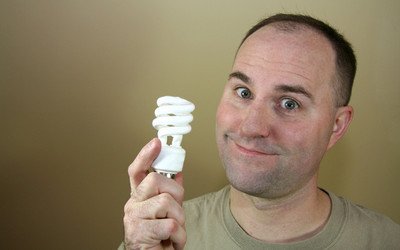Become more Earth-friendly in six simple steps

You’re not living off the grid, you don’t have a compost pile and the idea of recycling rainwater hasn’t even crossed your mind. Heck, you’re lucky to get your recycling to the curb each week.
Don’t sweat it. There are plenty of small, simple steps you can take to green your home and save big on your utility bills — and believe it or not, the little things make a big difference.
“Some of the most important things we can do take just a few minutes and cost only a few dollars. Some changes are even free but pay huge dividends to the environment,” said Jodi Helmer, author of “The Green Year: 365 Small Things You Can Do to Make a Big Difference” ($15, Alpha, December 2008).
They may seem small, but these six steps help in surprising ways.
“Taking the time to make your home more energy efficient and environmentally friendly helps minimize waste, reduce your carbon footprint, protect nonrenewable resources, save wildlife and preserve the environment for future generations,” she said.
1) Save the juice: Turn off unnecessary lights, pull the plug on idle appliances and say goodbye to the vintage fridge in your garage chilling that lonely six-pack. In other words: If it’s not in use, don’t use the juice.
“We take electricity for granted, but trace the wires back from your toaster and into the wall, and odds are they lead to a coal plant. When we burn coal, we heat the planet,” said James Glave, author of “Almost Green: How I Saved 1/6th of a Billionth of the Planet” ($25, Skyhorse Publishing).
Keep in mind that many appliances, such as hairdryers, electric can openers, computers and televisions, draw power even when turned off. Use a surge protector with an on/off switch to reduce the phantom power drain.
“Every time that little disc inside your power meter makes another lap, money drains out of your bank account. Why let the utility company have it?” Glave said.
2) Turn down the thermostat: “While there are huge things you can do to be more green — solar panels, wind power, geothermal heating and cooling — the average homeowner cannot afford these changes,” said Ace Hardware spokesman Lou Manfredini, the “Helpful Hardware Man.”
The average homeowner can, however, afford an Energy Star programmable thermostat. Prices start at around $30, they take just minutes to install and they help home heating and cooling systems operate at peak efficiency.
Set the thermostat to kick back during the day while the house is empty and at night while the family sleeps. You’ll see big savings — up to 20 percent on your heating and cooling bills, Manfredini said.
3) Look at your lighting: If you haven’t already, it’s time to switch to CFLs, or compact fluorescent light bulbs. They last longer, use significantly less energy than their incandescent counterparts and add up to big savings.
In fact, the energy savings and resulting environmental impact are so great that Congress approved legislation to phase out incandescent lighting by 2012. Get on board now and you’ll be saving money in no time.
“CFL bulbs use 75 percent less electricity and can last up to six years,” Manfredini said. “Replace the six most-used bulbs in your home and save up to $60 a year on your electric bills.”
4) Choose the cold cycle: About 90 percent of the energy consumed by your washing machine is used to heat the water. So unless you’re treating stains or washing bed linens, use the cold cycle with a cold-water, eco-friendly detergent, Helmer said.
“Choosing the ‘cold’ setting uses significantly less energy and is just as effective as hot water for getting your clothes clean,” she said.
5) Adjust the water heater: Lower the setting on your water heater. Ideally, the thermostat should sit at 120 degrees, but for each 10-degree reduction in temperature you’ll save 3 to 5 percent on your monthly energy bill, Helmer said.
“Reducing the temperature to 120 degrees also slows mineral buildup and prevents corrosion in your water heater and pipes. The result — a water heater that operates at its maximum efficiency,” she said.
6) Clean your coils: Refrigerator coils, which hold liquid that cools the air inside the unit, should be cleaned at least twice a year. Pull the fridge out from the wall, vacuum the dust and wipe the coils clean with a damp cloth.
“In just a few minutes, you can cut your refrigerator’s energy use by up to 6 percent,” Helmer said. “It takes a lot more energy to cool the refrigerator when the coils are covered with lint and dust.”












